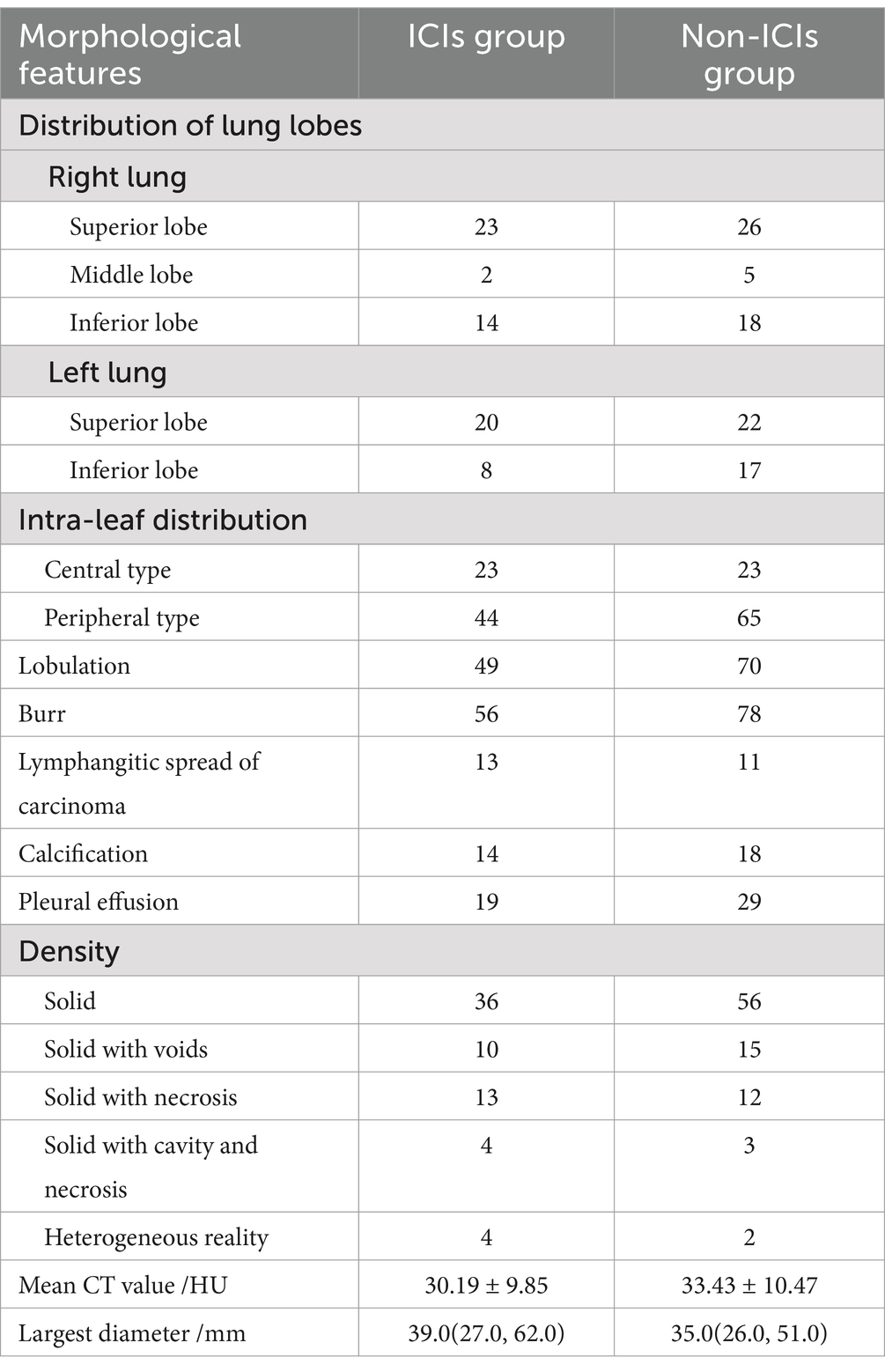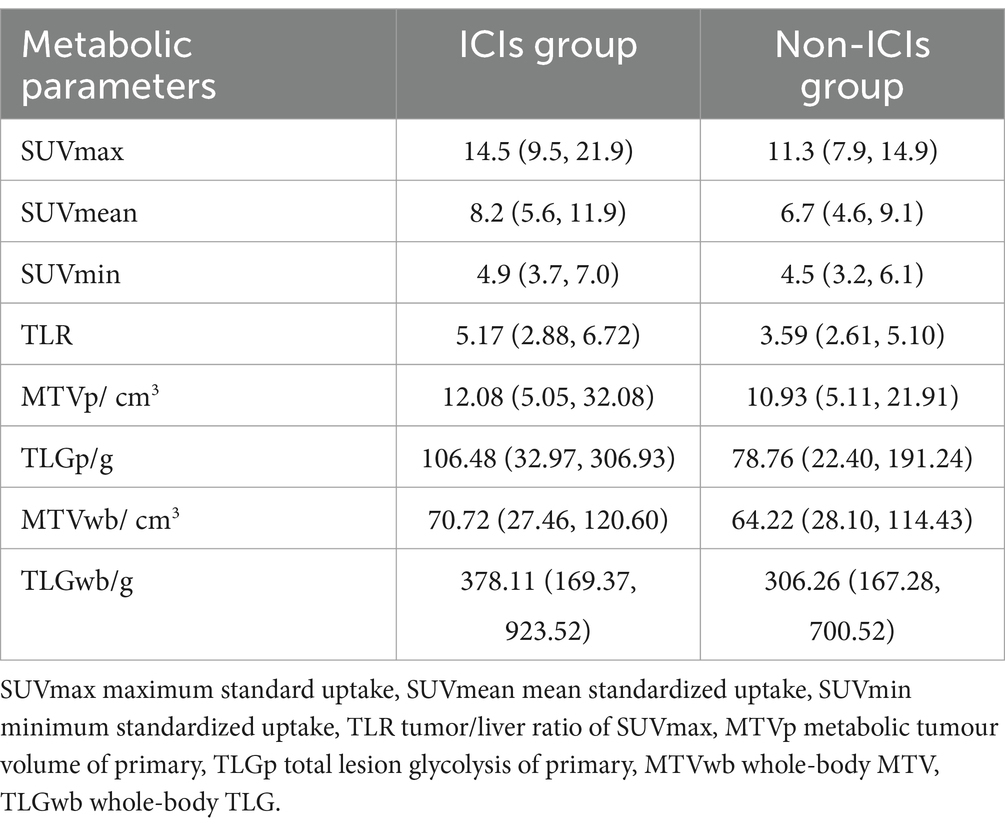- 1Department of Nuclear Medicine, Hebei General Hospital, Shijiazhuang, China
- 2Hebei Provincial Key Laboratory of Cerebral Networks and Cognitive Disorders, Shijiazhuang, China
- 3Department of Nuclear Medicine, Affiliated Hospital of Hebei University, Baoding, China
Objective: To analyse positron emission tomography/ computed tomography (PET/CT) imaging and clinical data from patients with non-small cell lung cancer (NSCLC), to identify characteristics of survival beneficiaries of immune checkpoint inhibitors (ICIs) treatment and to establish a survival prediction model.
Methods: A retrospective analysis was conducted on PET/CT imaging and clinical parameters of 155 NSCLC patients who underwent baseline PET/CT examination at the Department of Nuclear Medicine, Hebei General Hospital. The Kaplan–Meier curve was employed to compare progression-free survival (PFS) and overall survival (OS) between the ICIs and non-ICIs group and to assess the impact of variables on PFS and OS in the ICIs group. Multivariate Cox proportional hazards regression analysis was conducted with parameters significantly associated with survival in univariate analysis.
Results: Significant differences were observed in PFS (χ2 = 11.910, p = 0.0006) and OS (χ2 = 8.343, p = 0.0039). Independent predictors of PFS in the ICIs group included smoking history[hazard ratio (HR) = 2.522, 95% confidence interval (CI): 1.044 ~ 6.091, p = 0.0398], SUVmax of the primary lesion(HR = 0.2376, 95%CI: 0.1018 ~ 0.5548, p = 0.0009), MTVp (HR = 0.0755, 95%CI: 0.0284 ~ 0.2003, p < 0.001), and TLGp (HR = 0.1820, 95%CI: 0.0754 ~ 0.4395, p = 0.0002). These were also independent predictors of OS in the ICIs group[HR(95%CI) were 2.729 (1.125 ~ 6.619), 0.2636 (0.1143 ~ 0.6079), 0.0715 (0.0268 ~ 0.1907), 0.2102 (0.0885 ~ 0.4992), both p < 0.05)]. Age was an additional independent predictor of OS (HR = 0.4140, 95%CI: 0.1748 ~ 0.9801, p = 0.0449).
Conclusion: Smoking history, primary lesion SUVmax, MTVp, and TLGp were independent predictors of PFS, whilst age, smoking history, SUVmax, MTVp, and TLGp were independent predictors of OS in the ICIs group. Patients without a history of smoking and with SUVmax ≤19.2, MTVp ≤20.745cm3, TLGp ≤158.62 g, and age ≤ 60 years benefited more from ICI treatment.
1 Introduction
Lung cancer is a primary malignancy originating from the trachea, bronchial mucosa, or glands, and can be classified into small cell lung cancer (SCLC) and non-small cell lung cancer (NSCLC) based on histological heterogeneity. NSCLC accounts for approximately 80–85% of all lung cancers, with a 5-year survival rate of only 10–16% for patients with advanced NSCLC (1, 2). According to the China’s latest cancer survey in 2022, lung cancer ranks first in incidence and mortality (3). Advances in medical treatment have led to an increasing number of immune checkpoint inhibitors (ICIs) being approved for lung cancer in China, and the application of immunotherapy in the treatment of NSCLC has gradually become more widespread. Preliminary studies (4, 5) have suggested that 18F-fluorodeoxyglucose (18F-FDG) uptake is associated with the efficacy of immunotherapy, with higher maximum standard uptake value (SUVmax) correlating with better treatment outcomes. However, higher metabolic tumour volume (MTV) and total lesion glycolysis (TLG) are associated with a higher non-response rate and worse prognosis in NSCLC patients treated with ICIs. The objective response rate to ICIs is approximately 20% with 10% of patients experiencing serious immune-related adverse events (irAEs) (6). This study aims to analyse positron emission tomography/ computed tomography (PET/CT) imaging and clinical data of NSCLC patients treated with and without ICIs, comparing differences in progression-free survival (PFS) and overall survival (OS), and identifying characteristics of patients who benefit from ICIs. A survival prediction model based on 18F-FDG PET/CT parameters is developed to aid in the screening of NSCLC patients for immunotherapy.
2 Materials and methods
2.1 Patients
Clinical and imaging data of NSCLC patients who underwent baseline 18F-FDG PET/CT were retrospectively reviewed at Hebei General Hospital from January 2016 to April 2023. Inclusion criteria were: patients with pathologically confirmed NSCLC, no history of other malignancies or conditions affecting imaging agent uptake, 18F-FDG PET/CT performed within 1 week before treatment, and complete medical records. Exclusion criteria included patients unable to remain supine for an extended period during the examination and those who were lactating or pregnant.
A total of 174 patients’ baseline clinical information was collected and 155 patients were enrolled in the study after screening. This cohort included 67 patients treated with ICIs and 88 patients who were not treated with ICIs. Collected clinical data comprised age, gender, height, weight, body mass index (BMI), smoking history and status, drinking habits, family history of cancer, pathological type, Ki-67%, stage, and various tumour markers [carcinoembryonic antigen(CEA), squamous cell carcinoma antigen(SCC), Cytokeratin 19 fragment(CYFRA21-1), neuron specific enolase(NSE)], as well as lactate dehydrogenase(LDH), white blood cells(WBC) count, neutrophilic granulocyte(NE) count, erythrocyte sedimentation rate(ESR), and C-reactive protein (CRP).
2.2 18F-FDG PET/CT examination
Before the examination, patients fasted for at least 6 h and had fasting blood glucose levels ≤11.1 mmol/L. Body mass and height were measured. The 18F-FDG was provided by Hebei Andike Positron Technology Co., with a radiochemical purity of ≥95%. It was administered intravenously at a dose of 3.7–5.5 MBq/kg (0.10–0.15 mCi/kg) approximately 60 min before the PET/CT examination. Scanning was performed using the GE Discovery Elite PET/CT device, covering from the base of the skull to the middle and upper third of the thigh. CT parameters were set at 120 kV, 100 mA tube current, and 3.3 mm layer thickness. PET parameters included a 3D-TOF method for collecting PET images over 6–7 beds, with a 2-min acquisition time per bed. Images were reconstructed using full energy X-ray attenuation correction and ordered subset expectation maximisation algorithm, with a layer thickness of 3.3 mm. PET, CT and PET/CT fusion images were obtained, along with chest CT images reconstructed using a filtered back projection method with a 5 mm layer thickness and 1.25 mm thin-layer images.
2.3 Image analysis
PET/CT images were evaluated by two nuclear medicine physicians with advanced qualifications. Regions of interest (ROI) for each hypermetabolic lesion were identified on the PET/CT images, and the SUVmax was quantified. The mean standardized uptake value (SUVmean), minimum standardized uptake value (SUVmin), MTV of primary (MTVp) and TLG of primary (TLGp) were automatically extracted using a threshold of 40% of each SUVmax. The whole-body MTV(MTVwb) and whole-body TLG(TLGwb) for all lesions in each patient were calculated after determining the SUVmean and MTV for each ROI of all metastases. A circular ROI with a diameter of 1.0 cm (one in the left lobe and two in the right lobe) was delineated at normal metabolic sites in the liver, and the average SUVmax at these sites was used to calculate the tumor/liver ratio (TLR) of SUVmax (7). Lymph node and distant metastases in the PET/CT images were recorded. The characteristics of the primary lesion, including location, density, lobulation, burr, calcification, cancerous lymphangitis, and pleural effusion, were noted from the thin-slice CT images of the chest. The CT values of the primary lesion and the lengths of three radial lines were measured, with the maximum radial line length recorded as the maximum radial value.
2.4 Follow-up
Patients’ outcome information was obtained from electronic medical records, imaging reports, or telephone follow-ups until November 30, 2023. The follow-up duration ranged from 7 to 89 months, with a median of 26 months. Outcomes were classified according to response evaluation criteria in solid tumor (RECIST) criteria as complete response (CR), partial response (PR), progressive disease (PD), or stable disease (SD) (8). PFS and OS were recorded. PFS was defined as the time from the pathological diagnosis of NSCLC to disease progression, death from any cause, or the follow-up cutoff time. OS was defined as the time from pathological diagnosis to death from any cause or the follow-up cutoff time (9).
2.5 Statistical analysis
SPSS 25.0 was employed for data analysis. The Shapiro–Wilk test was used to assess normality, with normally distributed measurement data expressed as mean ± standard deviation (±SD) and non-normally distributed data presented as interquartile range (IQR). Classification variables were described as frequency (percentage). The Kaplan–Meier curve was used to compare PFS and OS between the ICIs and non-ICIs groups. Continuous variables in the ICIs group were dichotomised based on the optimal cut-off value from the receiver-operating characteristics (ROC) curve. The Kaplan–Meier curve assessed factors influencing PFS and OS in the ICIs group, and the log-rank test was used to analyse differences between groups. GraphPad Prism 9 was used to plot the curves. Statistically significant parameters identified in univariate analysis were included in the Cox proportional hazards regression model for multivariate analysis to determine independent predictors of PFS and OS. The ROC curve was used to validate the diagnostic efficacy of the risk prediction model. p < 0.05 was considered statistically significant.
3 Results
3.1 Basic information
3.1.1 Clinical data
Clinical data for the two groups are presented in Table 1. Amongst the 155 NSCLC, there are 67 cases in ICIs group with median age 65.0 (59.0, 70.0) years. The non-ICIs group had 88 cases with a median age of 67.0 (57.0, 74.8) years. There were more males than females in both groups (60 vs. 7.55 vs. 33). The most common pathologic types in the ICIs and non-ICIs groups were squamous carcinoma in 38 cases (56.7%) and adenocarcinoma in 63 cases (71.6%), respectively. There were no CR cases in both groups after follow-up.There were 8 (11.9%) cases of PR, 34 (50.7%) cases of SD, 25 (37.3%) cases of PD, 23 (34.3%) cases of death in the ICIs group. In the non-ICIs group, there were 1 (1.1%) PR, 28 (31.8%) SD, 59 (67.0%) PD, 58 (65.9%) deaths. TNM staging was determined according to the 8th edition of the lung cancer criteria (10).
3.1.2 PET/CT morphological characteristics and metabolic parameters
The primary lung lesions were predominantly located in the upper lobes, with 49 cases(31.6%, 49/155) in the right upper lobe and 42 cases(27.1%, 42/155) in the left upper lobe. Most lesions were peripheral (109 vs. 46). The morphology of the primary lesions varied, including lobulated, burr-like, lymphangitic spread of carcinoma, calcification, and pleural effusion. The density was predominantly homogeneous and solid. The average CT value of the primary lesions in the ICI group was 30.19 ± 9.85 HU, compared to 33.43 ± 10.47 HU in the non-ICI group. The largest diameter of the lesions was 39.0 mm (27.0, 62.0) in the ICI group and 35.0 mm (26.0, 51.0) in the non-ICI group (Table 2).
The PET/CT manifestations of primary lung cancer were characterised by high metabolic activity. Lymph node metastasis was observed in 130 cases(83.9%, 130/155), whilst distant metastasis was noted in 103 cases (66.5%, 103/155). Metabolic parameters of the primary lesions, including SUVmax, SUVmean, SUVmin, TLR, MTVp, TLGp, as well as MTVwb and TLGwb of all lesions, were assessed in both the ICI and non-ICI groups (Table 3).
3.2 Kaplan–Meier survival curve analysis
The 155 NSCLC patients were divided into two groups based on their treatment with ICIs: 67 cases(43.2%, 67/155) in the ICI group and 88 cases(56.8%, 88/155) in the non-ICI group. Kaplan–Meier survival analysis curves for PFS and OS were plotted for both groups (Figure 1). The average PFS and OS in the ICI group were 46.55 months and 50.47 months, respectively, compared to 28.60 months and 36.27 months in the non-ICI group. The differences in PFS(χ2 = 11.910, p = 0.0006) and OS(χ2 = 8.343, p = 0.0039) between the two groups were statistically significant, with patients in the ICI group experiencing longer PFS and OS than those in the non-ICI group.
3.3 Univariate and multivariate analysis of 18F-FDG PET/CT parameters and clinical features on PFS and OS in the ICIs group
3.3.1 Univariate analysis of 18F-FDG PET/CT parameters and clinical features for PFS and OS
All continuous variables in the ICI group were dichotomised based on the ROC curve’s cut-off value. These variables included clinical data such as age, height, weight, BMI, smoking status, Ki-67%, CEA, SCC, NSE, CYFRA21-1, LDH, WBC, NE, ESR, and CRP; PET/CT parameters such as the CT value and maximum diameter of the primary lesion, SUVmax, SUVmean, SUVmin, MTVp, TLGp, TLR, MTVwb, and TLGwb of all lesions; and various categorical variables including gender, smoking history, alcohol consumption, family history of cancer, pathological type, intralobular location of the primary lesion, and the presence or absence of lobulation, burr, cancerous lymphangitis, calcification, pleural effusion, lymph node metastasis, distant metastasis, and stage. These factors were evaluated using the Kaplan–Meier curve for survival analysis and the log-rank test for univariate analysis. The results indicated that factors influencing PFS included smoking history, CT value and maximum diameter of the primary focus, SUVmax, SUVmean, SUVmin, TLR, MTVp, TLGp, MTVwb, and TLGwb(χ2 = 4.224, 5.923, 13.366, 11.036, 4.984, 8.288, 8.906, 26.927, 14.35, 4.86, 13.932, all p < 0.05). For OS, the influencing factors were age, smoking history, SCC, primary CT value and maximum diameter, SUVmax, SUVmean, SUVmin, TLR, MTVp, TLGp, and total lesion TLGwb(χ2 = 4.023, 4.931, 4.712, 7.334, 12.497, 9.780, 5.095, 6.705, 7.765, 27.787, 12.487, 12.363, p < 0.05) (Table 4).
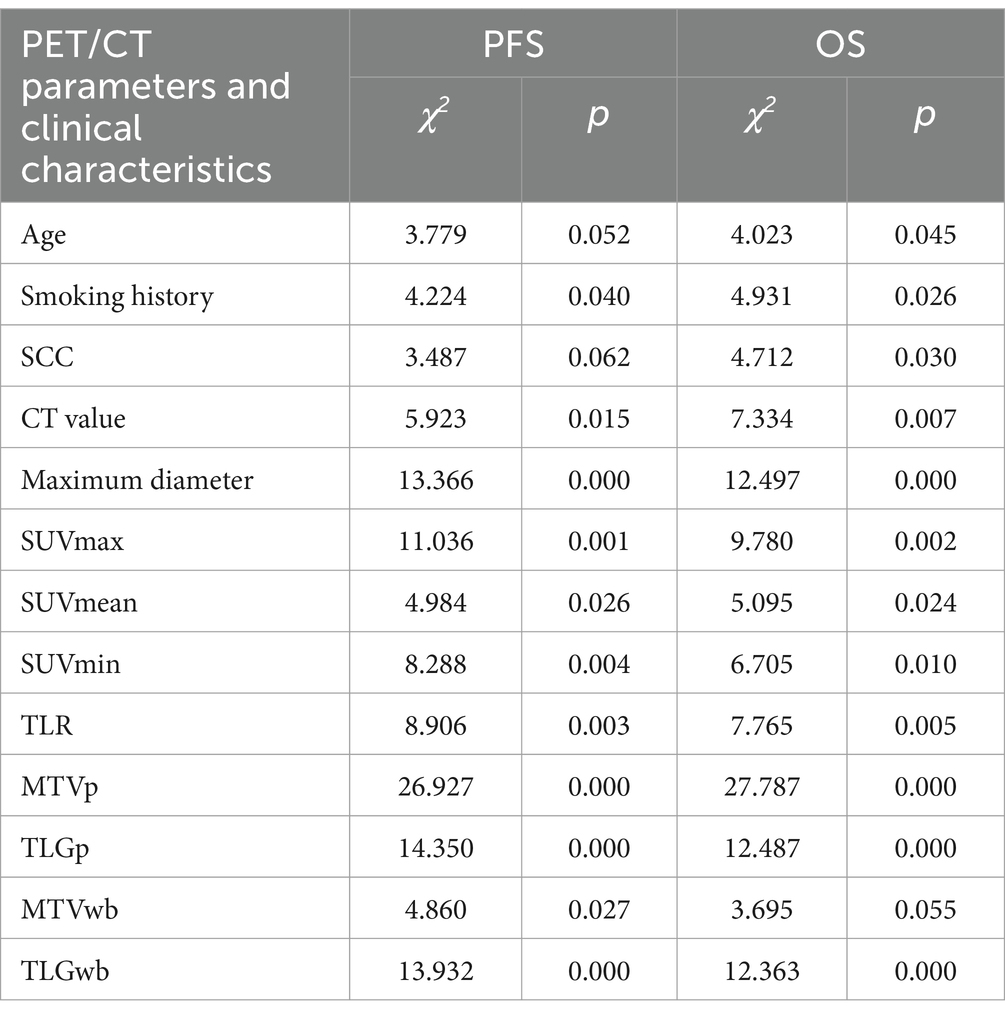
Table 4. Univariate analysis of 18F-FDG PET/CT parameters and clinical characteristics for PFS and OS in ICIs group.
3.3.2 Multivariate analysis of 18F-FDG PET/CT parameters and clinical features on PFS and OS
Statistically significant indicators from univariate analysis were included in Cox multivariate analysis. This analysis identified smoking history[hazard ratio (HR) = 2.522, 95% confidence interval (CI): 1.044 ~ 6.091. p = 0.0398], primary SUVmax(HR = 0.2376, 95%CI: 0.1018 ~ 0.5548, p = 0.0009), MTVp(HR = 0.0755, 95%CI: 0.0284 ~ 0.2003, p < 0.001), and TLGp(HR = 0.1820, 95%CI: 0.0754 ~ 0.4395, p = 0.0002) as independent predictors of PFS in the ICI group (Figure 2). These parameters were also independent predictors of OS[HR (95%CI) were 2.729 (1.125–6.619), 0.2636 (0.1143 ~ 0.6079), 0.0715 (0.0268 ~ 0.1907) and 0.2102 (0.0885 ~ 0.4992), respectively, p < 0.05), with age(HR = 0.4140, 95%CI: 0.1748–0.9801, p = 0.0449) additionally emerging as an independent predictor of OS (Figure 3). The findings indicated that NSCLC patients without a smoking history and with a primary SUVmax ≤19.2, MTVp ≤20.745cm3, TLGp ≤158.62 g and age ≤ 60 experienced improved survival benefits following ICI treatment.
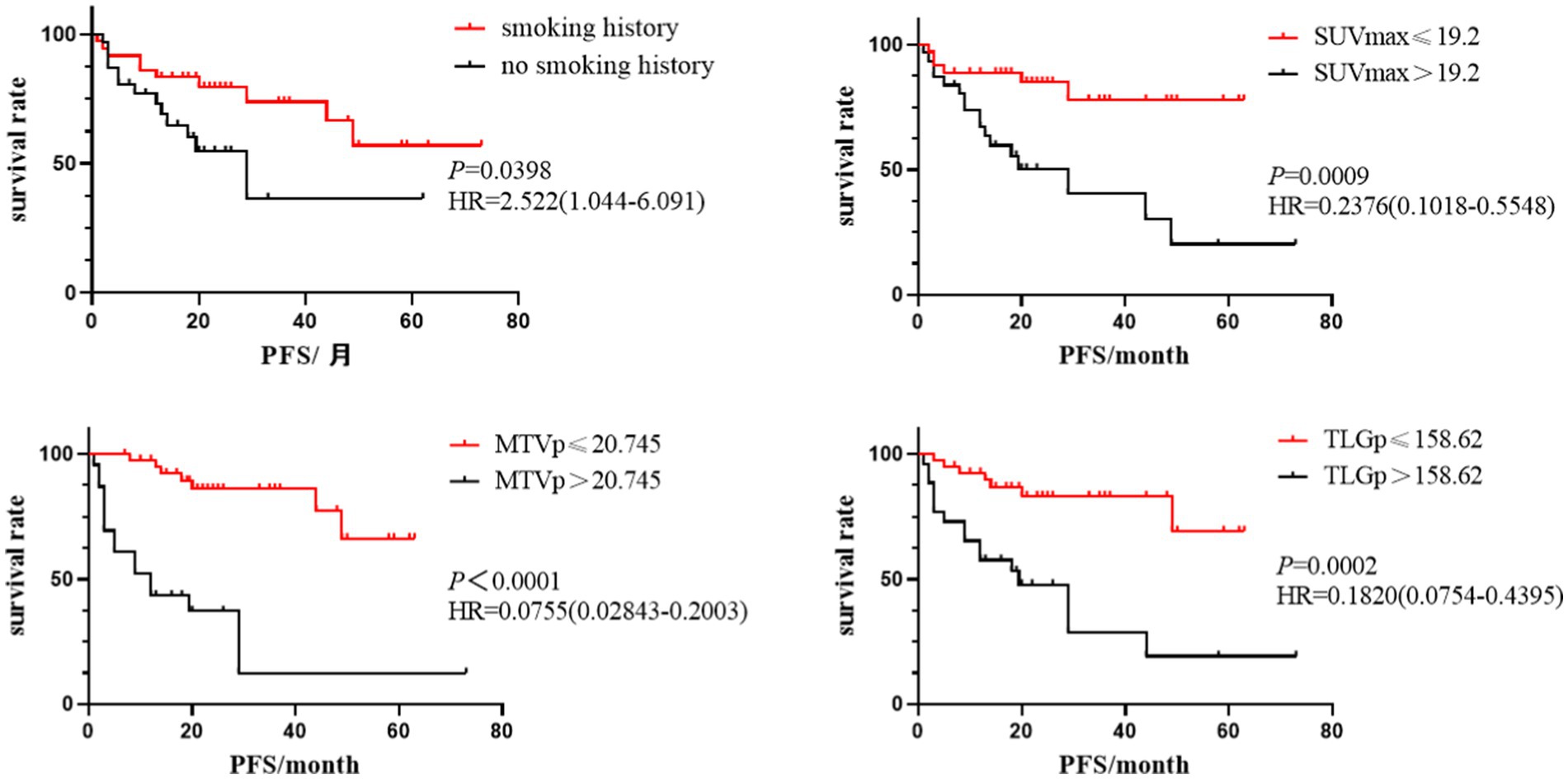
Figure 2. Kaplan–Meier survival analysis curves of smoking history, primary SUVmax, MTVp and TLGp on PFS in ICIs group.

Figure 3. Kaplan–Meier survival analysis curves of smoking history, primary SUVmax, MTVp, TLGp and age on OS in ICIs group.
The sensitivities for predicting PFS were 0.556, 0.742, 0.565, and 0.692 for smoking history, primary SUVmax, MTVp, and TLGp, respectively, with corresponding specificities of 0.774, 0.667, 0.864, and 0.585. The area under curves (AUC) were 0.707, 0.674, 0.766, and 0.652, respectively (Figure 4). For OS, the sensitivities were 0.694, 0.710, 0.522, 0.692, and 0.625 for smoking history, primary SUVmax, MTVp, TLGp, and age, respectively, with specificities of 0.839, 0.556, 0.841, 0.512, and 0.895, and AUC values of 0.671, 0.613, 0.718, 0.591, and 0.683, respectively (Figure 5). A Cox proportional hazards regression model was established to predict PFS and OS in the ICI group, and an ROC curve was used to assess the model’s diagnostic efficiency. The results showed that the sensitivity and specificity of the models based on smoking history, primary SUVmax, MTVp, and TLGp for predicting PFS were 77.3 and 73.9%, with an AUC of 0.692 (Figure 6). For OS, the models based on smoking history, primary SUVmax, MTVp, TLGp, and age had a sensitivity of 65.9%, specificity of 82.6%, and an AUC of 0.748 (Figure 7).
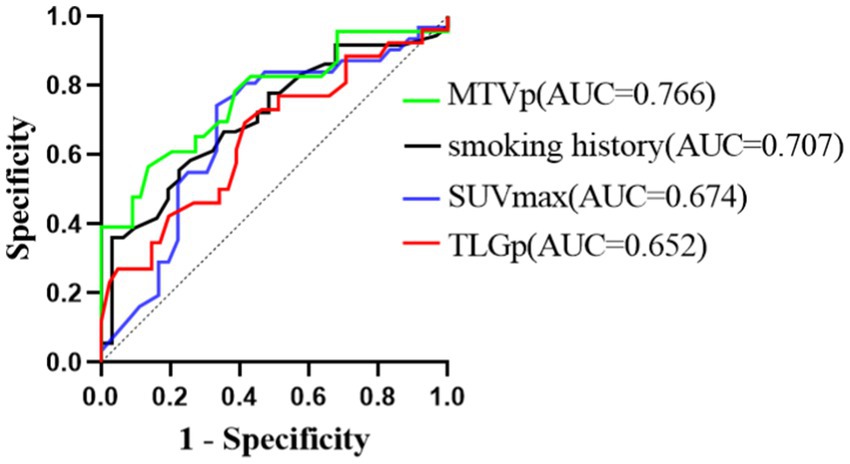
Figure 4. ROC curve of PFS predicted by smoking history, primary SUVmax, MTVp and TLGp in ICIs group.
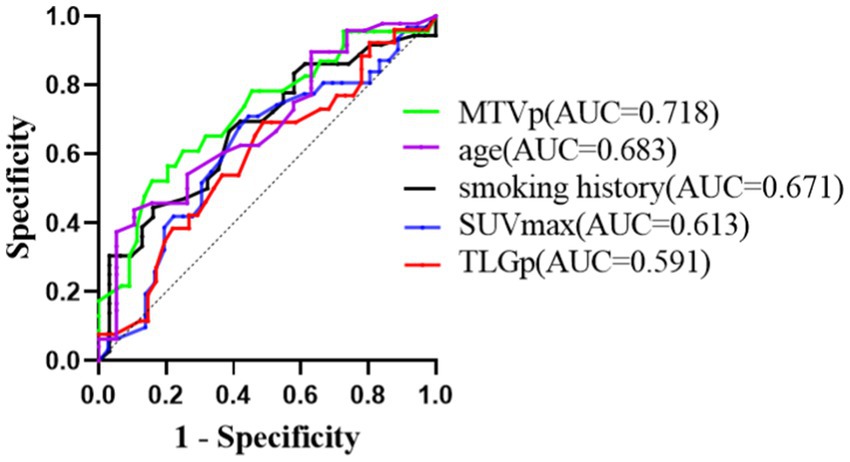
Figure 5. ROC curve of OS predicted by smoking history, primary SUVmax, MTVp, TLGp and age in ICIs group.
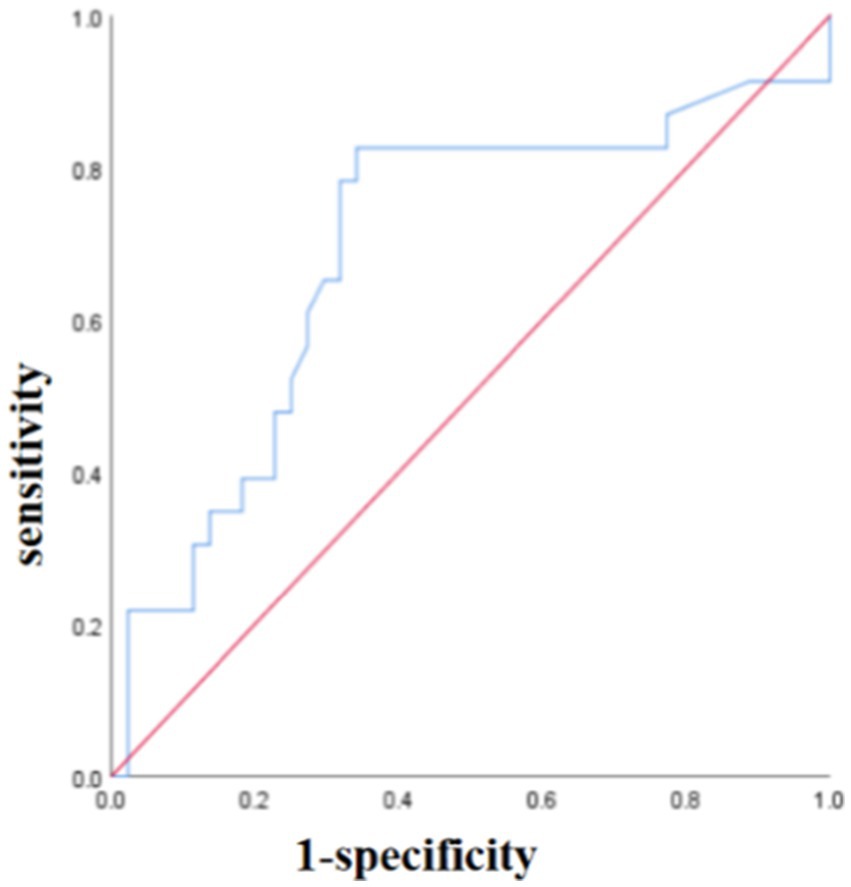
Figure 6. The ROC curve of PFS predicted by smoking history, primary SUVmax, MTVp and TLGp models in ICIs group.

Figure 7. The ROC curve of OS predicted by age, smoking history, primary SUVmax, MTVp and TLGp models in ICIs group.
4 Discussion
NSCLC constitutes over 80% of all lung cancer cases, with most patients experiencing asymptomatic onset in the early stages. Nearly 70% of newly diagnosed NSCLC patients present at an advanced stage, with a 5-year survival rate of only 10 to 16% (2, 11). Currently, immunotherapy is being applied to some patients with advanced NSCLC. Immune checkpoint molecules are protective elements in the human immune system, normally regulating T cell differentiation and proliferation to maintain immune balance. However, overexpression of these immune checkpoint molecules in tumour tissues inhibits T cell activation and proliferation or induces T cell apoptosis, creating an immunosuppressive tumour microenvironment that allows tumour cells to evade immune surveillance and destruction. The use of ICIs, such as those targeting programmed death 1 (PD-1), programmed death-ligand 1(PD-L1) and cytotoxic T lymphocyte-associated antigen-4 (CTLA-4), blocks the interaction between tumour tissues and T cells, thereby restoring normal immune function and providing significant survival benefits to patients (12). In recent years, tumour immunotherapy has expanded treatment options for patients with advanced NSCLC, with ICIs targeting PD-1, PD-L1, and CTLA-4 becoming a clinical hotspot.
At present, the objective remission rate for NSCLC patients undergoing immunotherapy is only 20%, with notable individual variability and a higher incidence of serious irAEs (6). 18F-FDG PET/CT is widely utilised in the diagnosis, efficacy evaluation, and prognosis assessment of lung cancer due to its non-invasive and comprehensive nature globally (13). This study aims to explore the predictive value of 18F-FDG PET/CT parameters for ICIs treatment effects in NSCLC patients and to develop a survival prediction model. We retrospectively included 155 NSCLC patients who underwent baseline 18F-FDG PET/CT at Hebei General Hospital from January 2016 to April 2023. Our findings suggest that ICIs treatment for advanced NSCLC patients provides significant survival benefits (1, 14). Compared to the non-ICIs group, the PFS and OS were significantly improved in the ICIs group, aligning with previous research results (5). Clinical data analysis revealed that elderly males, with a median age of 66 years, were the most common demographic, and adenocarcinoma was the predominant pathological type, consistent with epidemiological data and earlier studies (15). The baseline 18F-FDG PET/CT metabolic parameters in NSCLC patients are closely linked to general data and lesion morphological characteristics. Therefore, these parameters should be assessed in conjunction with other clinical and scientific data to provide a more personalised and accurate diagnosis and treatment plan.
Univariate analysis of 18F-FDG PET/CT parameters and clinical characteristics in the ICIs treatment group identified several factors influencing PFS, including smoking history, CT value and maximum diameter, SUVmax, SUVmean, SUVmin, TLR, MTVp, TLGp, MTVwb, and TLGwb. For OS, the influencing factors included age, smoking history, SCC, CT value and maximum diameter, SUVmax, SUVmean, SUVmin, TLR, MTVp, TLGp, and TLGwb. Independent predictors of PFS in the ICIs group were smoking history, primary SUVmax, MTVp, and TLGp. For OS, the independent predictors included age, smoking history, primary SUVmax, MTVp, and TLGp. Smoking history is a well-known risk factor for lung cancer, with studies indicating that the earlier smoking starts, the higher the risk of developing lung cancer, increasing 14 - fold, 8 - fold, and 5 - fold for children, adolescents, and adults, respectively, along with increased mortality (16). In this study, smoking history emerged as an independent predictor of both PFS and OS in NSCLC patients. Xu et al. (17) suggested that smoking status (pack-years), smoking duration, and time to quit smoking could be effective predictors of lung cancer incidence and mortality. However, smoking quantity alone was not an independent risk factor for NSCLC survival in this study, possibly due to the small sample size or inaccuracies in patient smoking data. Ken et al. (5) found that age, primary SUVmax, MTVp, and TLGp were effective predictors of long-term prognosis in NSCLC patients receiving ICIs, aligning with our multifactorial analysis results. Their study also identified carcinomatous lymphangiopathy as an independent predictor, though this finding may vary due to difficulties in diagnosing carcinomatous lymphangiopathy, potentially complicated by other lung conditions like interstitial fibrosis or inflammation. Giulia et al. (15) showed that MTV and TLG are important prognostic factors, positively correlating with disease progression, though SUVmax showed no correlation with PFS and OS, possibly due to differences in study populations and individual disease heterogeneity. In our study, MTVp predicted PFS and OS in ICIs-treated advanced NSCLC patients with AUCs of 0.766 and 0.718, indicating high predictive efficacy. Hye et al. (7) suggested that TLR is an independent prognostic factor for disease recurrence and patient survival in stage IB and IIA NSCLC, though its prognostic value in advanced stages remains unclear and requires further investigation. Karolien et al. (18) found that survival was not related to baseline MTVwb. Similarly, in our study, neither MTVwb nor TLGwb effectively predicted therapeutic response to ICIs in NSCLC patients. The findings indicate that NSCLC patients with no smoking history and primary SUVmax ≤19.2, MTVp ≤20.745cm3, TLGp ≤158.62 g and age ≤ 60 who received ICIs treatment experienced better survival benefits. This information could aid in the clinical screening of patients suited for ICIs treatment, improving the objective response and effective response rates and offering NSCLC patients better prognostic outcomes. Based on these results, PFS and OS prediction models for the ICIs group were established using the Cox proportional hazards regression model, with ROC curve analysis showing AUCs of 0.692 and 0.748, respectively, demonstrating good predictive efficiency.
The non-ICIs group did not undergo ICIs treatment for 3 main reasons: firstly, time reasons prevented some patients from applying ICIs treatment. The 155 patients included in this paper were screened from January 2016. Whilst ICIs therapy has emerged in recent years and gradually entered the clinic for the benefit of patients. Secondly, ICIs therapy requires patients to have some clinical indications. Finally, ICIs therapy is currently expensive and requires a certain economic basis to support patients to receive a sufficient course of treatment to achieve the therapeutic purpose. These leads to some patients not being able to apply ICIs.
This study has certain limitations. Although pathological biopsy is crucial for accurately assessing tumour nature and progression, sampling quality can be affected by various factors, and practical issues arise with multiple and continuous pathological examinations. The study did not fully obtain expression data for PD-1 and other immune checkpoints through immunohistochemistry. As a retrospective study, it may be subject to selection bias. Additionally, the absence of an external validation of monocentric data with small sample size and the lack of subgroup analyses for first-line versus second-line ICIs treatment and specific medication regimens limit the generalizability of the findings. The external validation of larger samples of multicenter data is needed in the future.
5 Conclusion
(1) Compared with the non-ICIs group, ICIs treatment significantly improves survival and prolongs survival time in NSCLC patients. (2) Smoking history, primary SUVmax, MTVp, and TLGp are independent predictors of PFS in the ICIs group. Age, smoking history, primary SUVmax, MTVp, and TLGp are independent predictors of OS in the ICIs group. All these predictors exhibit good forecasting efficiency. (3) NSCLC patients without a smoking history and with a primary SUVmax ≤19.2, MTVp ≤20.745cm3, TLGp ≤158.62 g and age ≤ 60 experience better survival benefits following ICIs treatment.
Data availability statement
The original contributions presented in the study are included in the article/supplementary material, further inquiries can be directed to the corresponding author.
Ethics statement
The studies involving humans were approved by Institutional Review Board of Hebei General Hospital. The studies were conducted in accordance with the local legislation and institutional requirements. The participants provided their written informed consent to participate in this study.
Author contributions
LZ: Data curation, Formal analysis, Investigation, Methodology, Software, Writing – original draft. YB: Conceptualization, Funding acquisition, Project administration, Supervision, Writing – review & editing. YH: Data curation, Software, Writing – review & editing. CT: Data curation, Software, Writing – review & editing. XZ: Data curation, Writing – review & editing. SL: Data curation, Writing – review & editing. XY: Data curation, Writing – review & editing. YQ: Data curation, Writing – review & editing.
Funding
The author(s) declare that financial support was received for the research, authorship, and/or publication of this article. The government funded the training project for outstanding talents in clinical medicine in 2021(2021037), Key Science and Technology Research Program of the Health Commission of Hebei Province (20241560).
Acknowledgments
We would like to thank the patient for agreeing to our reporting of her case and all the medical staff involved in the patient’s diagnosis and treatment.
Conflict of interest
The authors declare that the research was conducted in the absence of any commercial or financial relationships that could be construed as a potential conflict of interest.
Publisher’s note
All claims expressed in this article are solely those of the authors and do not necessarily represent those of their affiliated organizations, or those of the publisher, the editors and the reviewers. Any product that may be evaluated in this article, or claim that may be made by its manufacturer, is not guaranteed or endorsed by the publisher.
References
1. Du, Y, Fan, CJ, Shen, WX, and Xin, T. Progress in immunotherapy of non-small cell lung cancer. J Mod Oncol. (2021) 29:2368–71. doi: 10.3969/j.issn.1672-4992.2021.13.038
2. Jeon, DS, Kim, HC, Kim, SH, Kim, TJ, Kim, HK, Moon, MH, et al. Five-year overall survival and prognostic factors in patients with lung Cancer: results from the Korean Association of Lung Cancer Registry (KALC-R) 2015. Cancer Res Treat. (2023) 55:103–11. doi: 10.4143/crt.2022.264
3. Zheng, RS, Chen, R, Han, BF, Wang, SM, Li, L, Sun, KX, et al. Cancer incidence and mortality in China, 2022. J Natl Cancer Cent. (2024) 4:47–53. doi: 10.1016/j.jncc.2024.01.006
4. Hashimoto, K, Kaira, K, Yamaguchi, O, Mouri, A, Shiono, A, Miura, Y, et al. Potential of FDG-PET as prognostic significance after anti-PD-1 antibody against patients with previously treated non-small cell lung Cancer. J Clin Med. (2020) 9:725–5. doi: 10.3390/jcm9030725
5. Kudura, K, Ritz, N, Kutzker, T, Hoffmann, MHK, Templeton, AJ, Foerster, R, et al. Predictive value of baseline FDG-PET/CT for the durable response to immune checkpoint inhibition in NSCLC patients using the morphological and metabolic features of primary tumors. Cancers. (2022) 14:6095–5. doi: 10.3390/cancers14246095
6. Cui, SH, Ge, XX, and Li, XY. A real-world study on the incidence and outcome of immune-related adverse events in lung Cancer patients. Zhongguo Fei Ai Za Zhi. (2023) 26:257–64. doi: 10.3779/j.issn.1009-3419.2023.101.08
7. Park, HL, Boo, SH, Park, SY, Moon, SW, and Yoo, IR. Prognostic value of TLR from FDG PET/CT in patients with margin-negative stage IB and IIA non-small cell lung cancer. Eur Radiol. (2023) 33:7274–83. doi: 10.1007/s00330-023-09641-w
8. Singla, R, Jajodia, A, Agrawal, RK, Rao, A, Pasricha, S, and Batra, U. Comparison of RECIST and iRECIST criteria in patients with advanced lung cancer treated with nivolumab. J Cancer Res Ther. (2023) 19:1212–8. doi: 10.4103/jcrt.jcrt_1456_21
9. Feng, YW, Wang, P, Chen, YQ, and Dai, WL. 18F-FDG PET/CT for evaluation of metastases in nonsmall cell lung cancer on the efficacy of immunotherapy. Nucl Med Commun. (2023) 44:900–9. doi: 10.1097/MNM.0000000000001737
10. Li, H. Overview of the AJCC lung Cancer staging system, eighth edition may give us more thought: opportunities and challenges. Zhonghua Wai Ke Za Zhi. (2017) 55:346–50. doi: 10.3760/cma.j.issn.0529-5815.2017.05.007
11. Xu, X, Li, JH, Yang, Y, Sang, SB, and Deng, SM. The correlation between PD-L1 expression and metabolic parameters of 18F-FDG PET/CT and the prognostic value of PD-L1 in non-small cell lung cancer. Clin Imag. (2022) 89:120–7. doi: 10.1016/j.clinimag.2022.06.016
12. Lin, L, Xiao, L, Li, L, Chen, C, Zhang, HR, Yu, CY, et al. A meta-analysis of the efficacy of programmed cell death 1/its ligand inhibitors plus cytotoxic T-lymphocyte-associated antigen 4 inhibitors in non-small cell lung cancer. Front Pharmacol. (2024) 15:1267763. doi: 10.3389/fphar.2024.1267763
13. Evangelista, L, Cuocolo, A, Pace, L, Mansi, L, Del Vecchio, S, Miletto, P, et al. Performance of FDG-PET/CT in solitary pulmonary nodule based on pre-test likelihood of malignancy: results from the ITALIAN retrospective multicenter trial. Eur J Nucl Med Mol I. (2018) 45:1898–907. doi: 10.1007/s00259-018-4016-1
14. Valentinuzzi, D, Vrankar, M, Boc, N, Ahac, V, Zupancic, Z, Unk, M, et al. 18F-FDG PET immunotherapy radiomics signature (iRADIOMICS) predicts response of non-small-cell lung cancer patients treated with pembrolizumab. Radiol Oncol. (2020) 54:285–94. doi: 10.2478/raon-2020-0042
15. Polverari, G, Ceci, F, Bertaglia, V, Reale, ML, Rampado, O, Gallio, E, et al. 18F-FDG pet parameters and Radiomics features analysis in advanced Nsclc treated with immunotherapy as predictors of therapy response and survival. Cancers. (2020) 12:1163. doi: 10.3390/cancers12051163
16. He, H, He, MM, Wang, HX, Qiu, WH, Liu, L, Long, L, et al. In utero and childhood/adolescence exposure to tobacco smoke, genetic risk and lung Cancer incidence and mortality in adulthood. Am J Resp Crit Care. (2023) 207:173–82. doi: 10.1164/rccm.202112-2758OC
17. Gao, X, Huang, NH, Jiang, MJ, Holleczek, B, Schöttker, B, Huang, T, et al. Mortality and morbidity risk prediction for older former smokers based on a score of smoking history: evidence from UK biobank and ESTHER cohorts. Age Ageing. (2022) 51:154. doi: 10.1093/ageing/afac154
Keywords: PET/CT, SUV, non-small cell lung cancer, immune checkpoint inhibitors, prognosis
Citation: Zheng L, Bian Y, Hu Y, Tian C, Zhang X, Li S, Yang X and Qin Y (2025) Baseline 18F-FDG PET/CT parameters in predicting the efficacy of immunotherapy in non-small cell lung cancer. Front. Med. 12:1477275. doi: 10.3389/fmed.2025.1477275
Edited by:
Alessandro Leonetti, University Hospital of Parma, ItalyReviewed by:
Salvatore Annunziata, Fondazione Policlinico Universitario A. Gemelli IRCCS, ItalyDing Chong Yang, Nanjing Medical University, China
Copyright © 2025 Zheng, Bian, Hu, Tian, Zhang, Li, Yang and Qin. This is an open-access article distributed under the terms of the Creative Commons Attribution License (CC BY). The use, distribution or reproduction in other forums is permitted, provided the original author(s) and the copyright owner(s) are credited and that the original publication in this journal is cited, in accordance with accepted academic practice. No use, distribution or reproduction is permitted which does not comply with these terms.
*Correspondence: Yanzhu Bian eWFuemh1Ymlhbjk5QDE2My5jb20=
 Lu Zheng
Lu Zheng Yanzhu Bian1,2*
Yanzhu Bian1,2* Congna Tian
Congna Tian
